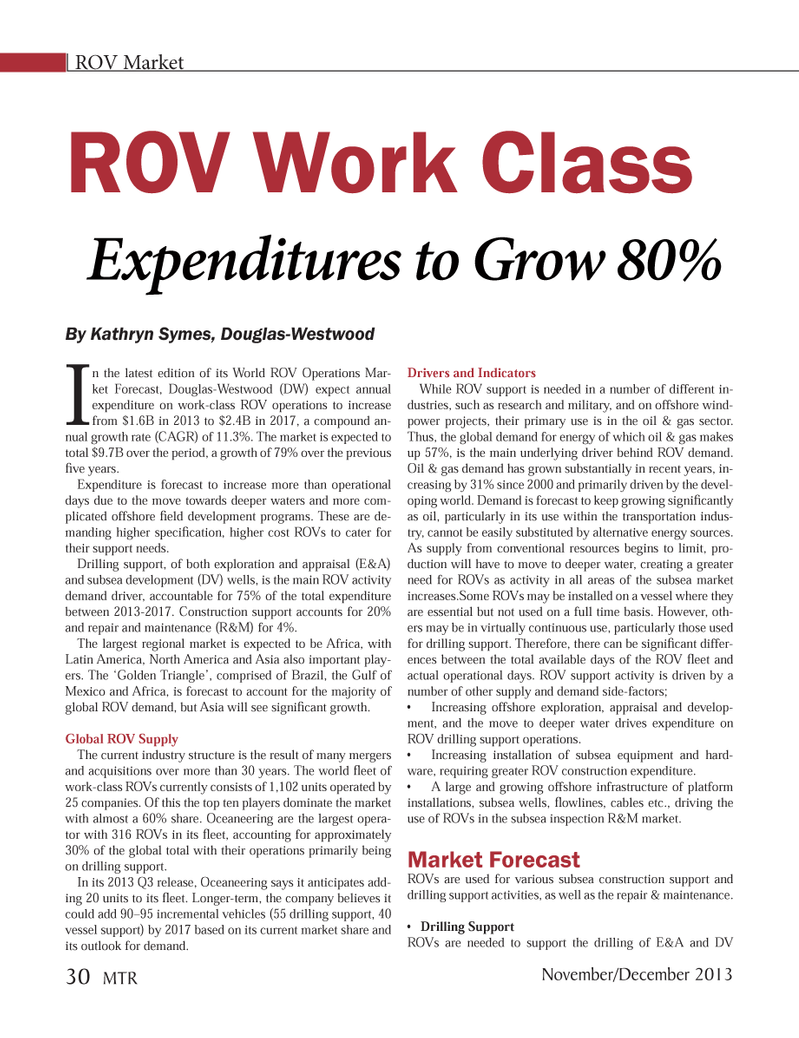
Page 30: of Marine Technology Magazine (November 2013)
Fresh Water Monitoring & Sensors
Read this page in Pdf, Flash or Html5 edition of November 2013 Marine Technology Magazine
ROV Market In the latest edition of its World ROV Operations Mar- ket Forecast, Douglas-Westwood (DW) expect annual expenditure on work-class ROV operations to increase from $1.6B in 2013 to $2.4B in 2017, a compound an-nual growth rate (CAGR) of 11.3%. The market is expected to total $9.7B over the period, a growth of 79% over the previous Þ ve years. Expenditure is forecast to increase more than operational days due to the move towards deeper waters and more com- plicated offshore Þ eld development programs. These are de- manding higher speciÞ cation, higher cost ROVs to cater for their support needs. Drilling support, of both exploration and appraisal (E&A) and subsea development (DV) wells, is the main ROV activity demand driver, accountable for 75% of the total expenditure between 2013-2017. Construction support accounts for 20% and repair and maintenance (R&M) for 4%. The largest regional market is expected to be Africa, with Latin America, North America and Asia also important play- ers. The ÔGolden TriangleÕ, comprised of Brazil, the Gulf of Mexico and Africa, is forecast to account for the majority of global ROV demand, but Asia will see signiÞ cant growth. Global ROV Supply The current industry structure is the result of many mergers and acquisitions over more than 30 years. The world ß eet of work-class ROVs currently consists of 1,102 units operated by 25 companies. Of this the top ten players dominate the market with almost a 60% share. Oceaneering are the largest opera- tor with 316 ROVs in its ß eet, accounting for approximately 30% of the global total with their operations primarily being on drilling support. In its 2013 Q3 release, Oceaneering says it anticipates add-ing 20 units to its ß eet. Longer-term, the company believes it could add 90Ð95 incremental vehicles (55 drilling support, 40 vessel support) by 2017 based on its current market share and its outlook for demand. Drivers and Indicators While ROV support is needed in a number of different in- dustries, such as research and military, and on offshore wind- power projects, their primary use is in the oil & gas sector. Thus, the global demand for energy of which oil & gas makes up 57%, is the main underlying driver behind ROV demand. Oil & gas demand has grown substantially in recent years, in- creasing by 31% since 2000 and primarily driven by the devel- oping world. Demand is forecast to keep growing signiÞ cantly as oil, particularly in its use within the transportation indus-try, cannot be easily substituted by alternative energy sources. As supply from conventional resources begins to limit, pro- duction will have to move to deeper water, creating a greater need for ROVs as activity in all areas of the subsea market increases.Some ROVs may be installed on a vessel where they are essential but not used on a full time basis. However, oth- ers may be in virtually continuous use, particularly those used for drilling support. Therefore, there can be signiÞ cant differ- ences between the total available days of the ROV ß eet and actual operational days. ROV support activity is driven by a number of other supply and demand side-factors; ¥ Increasing offshore exploration, appraisal and develop- ment, and the move to deeper water drives expenditure on ROV drilling support operations. ¥ Increasing installation of subsea equipment and hard- ware, requiring greater ROV construction expenditure. ¥ A large and growing offshore infrastructure of platform installations, subsea wells, ß owlines, cables etc., driving the use of ROVs in the subsea inspection R&M market. Market Forecast ROVs are used for various subsea construction support and drilling support activities, as well as the repair & maintenance. ¥ Drilling SupportROVs are needed to support the drilling of E&A and DV ROV Work Class Expenditures to Grow 80% By Kathryn Symes, Douglas-Westwood 30 MTRNovember/December 2013MTR #9 (18-33).indd 30MTR #9 (18-33).indd 3012/12/2013 11:12:05 AM12/12/2013 11:12:05 AM

 29
29

 31
31
